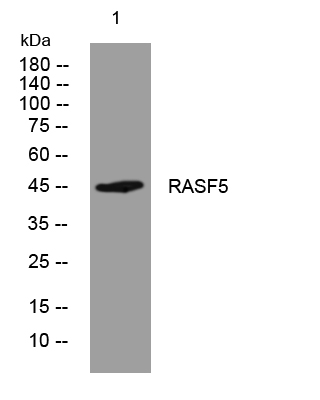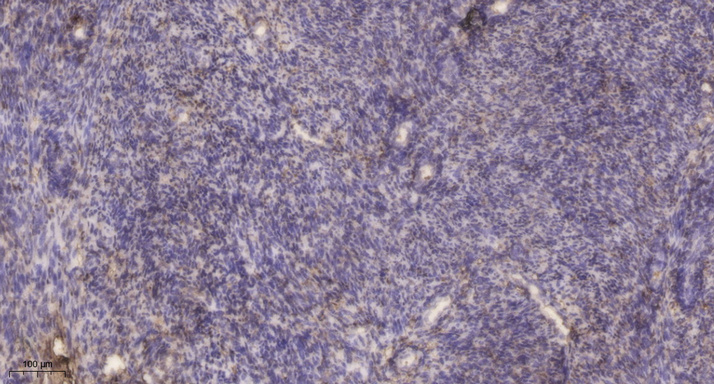RASF5 rabbit pAb
- Catalog No.:YT6737
- Applications:WB;IF;ELISA;IHC
- Reactivity:Human;Mouse;Rat
- Target:
- RASF5
- Fields:
- >>Ras signaling pathway;>>Rap1 signaling pathway;>>Cellular senescence;>>Leukocyte transendothelial migration;>>Pathways in cancer;>>Non-small cell lung cancer
- Gene Name:
- RASSF5 NORE1 RAPL
- Protein Name:
- RASF5
- Human Gene Id:
- 83593
- Human Swiss Prot No:
- Q8WWW0
- Mouse Gene Id:
- 54354
- Mouse Swiss Prot No:
- Q5EBH1
- Rat Gene Id:
- 54355
- Rat Swiss Prot No:
- O35141
- Immunogen:
- Synthesized peptide derived from human RASF5 AA range: 234-284
- Specificity:
- This antibody detects endogenous levels of RASF5 at Human/Mouse/Rat
- Formulation:
- Liquid in PBS containing 50% glycerol, 0.5% BSA and 0.02% sodium azide.
- Source:
- Polyclonal, Rabbit,IgG
- Dilution:
- WB 1:500-2000; IF ICC 1:50-200;ELISA 1:2000-20000;IHC 1:50-200
- Purification:
- The antibody was affinity-purified from rabbit antiserum by affinity-chromatography using epitope-specific immunogen.
- Concentration:
- 1 mg/ml
- Storage Stability:
- -15°C to -25°C/1 year(Do not lower than -25°C)
- Molecular Weight(Da):
- 46kD
- Background:
- This gene is a member of the Ras association domain family. It functions as a tumor suppressor, and is inactivated in a variety of cancers. The encoded protein localizes to centrosomes and microtubules, and associates with the GTP-activated forms of Ras, Rap1, and several other Ras-like small GTPases. The protein regulates lymphocyte adhesion and suppresses cell growth in response to activated Rap1 or Ras. Multiple transcript variants encoding different isoforms have been found for this gene. [provided by RefSeq, Jul 2008],
- Function:
- caution:Has been termed RASSF3 by Ref.3.,function:Potential tumor suppressor. Seems to be involved in lymphocyte adhesion by linking RAP1A activation upon T cell receptor or chemokine stimulation to integrin activation. Isoform 2 stimulates lymphocyte polarization and the patch-like distribution of ITGAL/LFA-1, resulting in an enhanced adhesion to ICAM1. Together with RAP1A may participate in regulation of microtubule growth. The association of isoform 2 with activated RAP1A is required for directional movement of endothelial cells during wound healing. May be involved in regulation of Ras apoptotic function. The RASSF5-STK4 complex may mediate HRAS1 and KRAS induced apoptosis.,similarity:Contains 1 phorbol-ester/DAG-type zinc finger.,similarity:Contains 1 Ras-associating domain.,similarity:Contains 1 SARAH domain.,subcellular location:Isoform 2 is mainly located in the perinuclear regio
- Subcellular Location:
- Cytoplasm. Cytoplasm, cytoskeleton. Isoform 2 is mainly located in the perinuclear region of unstimulated primary T-cells. Upon stimulation translocates to the leading edge and colocalizes with ITGAL/LFA-1 in the peripheral zone of the immunological synapse. Isoform 2 is localized to growing microtubules in vascular endothelial cells and is dissociated from microtubules by activated RAP1A.
- Expression:
- Widely expressed. Frequently down-regulated in lung tumor cell lines and primary lung tumors.
- June 19-2018
- WESTERN IMMUNOBLOTTING PROTOCOL
- June 19-2018
- IMMUNOHISTOCHEMISTRY-PARAFFIN PROTOCOL
- June 19-2018
- IMMUNOFLUORESCENCE PROTOCOL
- September 08-2020
- FLOW-CYTOMEYRT-PROTOCOL
- May 20-2022
- Cell-Based ELISA│解您多样本WB检测之困扰
- July 13-2018
- CELL-BASED-ELISA-PROTOCOL-FOR-ACETYL-PROTEIN
- July 13-2018
- CELL-BASED-ELISA-PROTOCOL-FOR-PHOSPHO-PROTEIN
- July 13-2018
- Antibody-FAQs
- Products Images

- Western blot analysis of lysates from Hela cells, primary antibody was diluted at 1:1000, 4°over night

- Immunohistochemical analysis of paraffin-embedded human uterus. 1, Antibody was diluted at 1:200(4° overnight). 2, Tris-EDTA,pH9.0 was used for antigen retrieval. 3,Secondary antibody was diluted at 1:200(room temperature, 45min).



